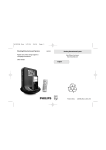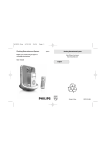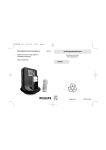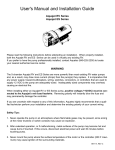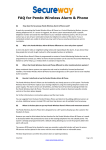Download Wireless Accessible Wheelchair Rail Scale User`s Manual
Transcript
Wireless Accessible Wheelchair Rail Scale User’s Manual Eric Bernstein Matt Veilleux Maria Elescano Julie Rosario Initializing the Scale: Since the entire scale is a wireless device, each section of the scale has its own power switch. However, in order to properly initialize the scale a certain procedure must be followed. Before activating the display, ensure that the units switch on the display is properly set. This switch is not intended to be changed while the system is powered on; doing so will result in invalid displayed weights. First the display unit must be turned on, followed by the two rails. After waiting approximately five seconds once turning on the rails, the display should be displaying a low offset value, typically between five and ten pounds. Pressing the “TARE” button on the display keypad will set the current value as the zero point and prepare the scale to accurately measure the weight on each rail. Failure to follow this initialization procedure would incorporate the initial offset value into the measurements taken on the scale. Quick Initialization Instructions: 1. Set the units switch on the display 2. Turn on the display power switch 3. Turn on the two rail power switches 4. Wait five seconds 5. Press the “TARE” button Setting a Wheelchair Subtraction Weight: Once the scale is initialized, many users will want to input the weight of their wheelchair in order to make the scale only display the actual weight of the patient. After a subtraction weight is entered, it is applied to every subsequent measurement until either the display unit is powered down or a new subtraction value is entered. If the weight on the scale is less than the value being subtracted, the display unit will display a value of zero since the scale is not capable of displaying negative weights. To enter a wheelchair subtraction weight, it is easiest to already have a weight on the scale to view the result of the subtraction; however this is not a requirement. First press the “SUB” button to enter the subtraction mode. At this point the display should start flashing in order to indicate that the display is no longer displaying the current weight and is in subtraction mode. Enter the subtraction value using the numerical keypad on the display in the currently selected units scale. For instance, if the scale unit select switch is set to pounds, the subtraction value must also be in pounds. After the weight is entered, the user needs to press the “SUB” button a second time to apply the subtraction value to the displayed value on the scale. Since loss of power results in a loss of the wheelchair subtraction weight setting it is important that the display unit is recharged when the low battery indicator is activated. Quick Wheelchair Subtraction Instructions: 1. Press the “SUB” button on the display 2. Enter the desired subtraction weight on the numerical keypad 3. Press the “SUB” button a second time Weight Memory Storage and Retrieval: Many patients may need to accurately track weight over a period of time for medication dosing or other purposes. To accommodate these patients, a two user memory capable of storing thirty data values each has been incorporated into the display. This memory is dependant upon constant power supplied to the display, so to prevent data loss the user is encouraged to recharge the display unit when the low power indicator is activated. Memory storage can be accomplished by pressing the “ENT” key whenever the scale is displaying a weight. By default, the display unit powers up with user one selected. However, user two can be selected by pressing “SRCH”, “2”, and “SRCH” again. Pressing the “ENT” key stores the currently displayed value as the most recent value in the selected user’s memory queue. Memory access is performed by pressing the “SRCH” key. In memory access mode the memory LED is activated to indicate that the currently displayed value is a memory value rather than the actual value of the scale. By default, after pressing the “SCRH” button, the most recently stored data value for the currently selected user is displayed. To access earlier values, the user must press the “DWN” key while later values are accessed by pressing the “UP” key. Selecting between viewing the data of different users is accomplished by pressing either “1” or “2” while in the memory search mode. The currently selected user is indicated by two user 1 and user 2 LED’s found to the right of the keypad. Quick Memory Storage Instructions: 1. If necessary, select desired user by pressing “SRCH”, “1” or “2”, and “SRCH” 2. Press “ENT” to store current value for selected user Quick Memory Access Instructions: 1. Press “SRCH” key 2. Select desired user by pressing “1” or “2” 3. Access earlier values by pressing “DWN” 4. Access later values by pressing “UP” Environmental and Weighing Considerations: To ensure the most accurate results, the two rails should be placed on a flat hard floor surface. Selection of a proper surface will ensure that the weight is properly distributed between the four feet of each rail and prevent the rails from moving while a wheelchair bound patient attempts to roll onto the scale. The ramps leading onto each of the rails have adjustable feet to ensure that the ramp lies flat against the ground and still can support the weight of the patient during loading. Simply turn the screws to raise the feet to the necessary height. The electronic boxes on both the display and the rails should be considered water resistant. For the rail electronics boxes, the external low power LED and power switch were sealed with plastic cement and the wireless antenna and box screws were tightened to prevent entrance of a moderate amount of water. The major issue is that the connector between the electronics box and the load cells is simply a slide connection to facilitate easy replacement of the load cells. As a result, if the scale is subjected to large amounts of water, a load cell short circuit could occur to affect the performance of the scale. However, since this connector is at least 3/4” above the ground, light spills under the rails should not affect the electronic components. The display unit is outfitted with a sealed keypad and a large plastic window to seal off the display LCD. Therefore, this scale is perfectly acceptable for use in a typical bathroom setting without any significant effects on the scale’s performance. Another important weighing consideration is that the scale is only calibrated to provide an accurate weight measurement at the center of each rail. As a result, users should ensure that their mass is focused towards the center of the scale. For most wheelchairs this should mean that the rear wheels should be as close to the center of the scale as possible. Following these guidelines should ensure that the proper weight is displayed. A final consideration when using the scale is that each rail is only 9.5 inches across. Since the front wheels of many wheelchairs are typically offset from the back wheels, patients must make sure these dimensions can still fit the rails. Also, depending on the design of the front wheels, assistance may be required to help patients lacking fine control of their wheelchairs movements to get on and off the scale. Wireless Procedures: The wireless transceivers built into the rails and the display have a maximum indoor range of approximately 150 feet. This feature allows the display to be placed virtually anywhere in relation to the rails. It can be placed on a flat surface or mounted on a wall for easy viewing. Also the wireless functionality means that the display unit can be placed in an adjoining room if the scale is being used for some sort of blind study where a remote viewer is tracking the weight without the patient being able to view the weight. If the display unit is far from the rails, transmission problems could prevent the weight from being displayed. To ensure adequate transmission strength, the best testing procedure is to simply disable the system and reinitialize it while making sure that the initial offset value is properly transmitted to the display. In order to reduce the affect of interference on other wireless devices, the scale only sends data over the wireless link when the weight on the scale changes. After a ten pound difference is detected between the current scale value and the value that was last transmitted, a measurement cycle is activated. Each measurement cycle consists of a two second window for the weight to stabilize followed by a two second measurement time. During measurement, approximately three thousand data values are acquired and averaged for each load cell to obtain the most accurate weight possible. The display unit has several error checking features to reduce the affect of bit errors on the displayed weight. A final note on the wireless units on the scale is that the transceivers are preapproved by the FCC directly from the manufacturer, so there should not be issues using the scale in a typical commercial setting. Battery Instructions: • • Batteries charge to full capacity for 3.5 hours. After the low battery indicator light turns on it takes 1 hour before the rail power shuts down and 3 hours for the display to shut down. Power source should be plug immediately after the low battery indicator light turns on in order to avoid device shutdown. Battery Specifications: • • • • • • • Electronic boxes should be kept at a temperature range of 0 0C to 55 0C. At temperatures below 00C leakage and deterioration of the batteries can occur. The electronic boxes should be place on room temperature while the batteries are charging. Charging efficiency is best within a temperature range of 100C to300C. Avoid overcharging of the batteries because it can lead to deterioration in battery performance. DO NOT take the batteries out of the electronics to recharge! Connecting the power supply automatically recharges the batteries. Never place the electronic boxes or batteries in fire. This can cause the batteries to burst and the electrolyte to spay out Never place the electronic boxes or batteries in water. This can cause the batteries to become hot or to rust, and it will also impair its performance. Do not use the battery in any other device or for any other purpose. Difference in specifications could result in damage to the device and to the battery. Cleaning: All of the electronics boxes are relatively sealed against moisture; therefore a damp cloth should be acceptable for cleaning the plastic boxes. On the display unit, Windex or some other window cleaner should be used to keep the plastic window for the LCD clean. The rail carpet can be cleaned with a normal vacuum cleaner without affecting the load cell performance. The wood siding on the rails can be cleaned with any typical wood cleaner.







